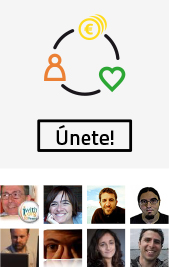
Curso sobre educación transformadora
Os presentamos una nueva edición (Noviembre 2025) del curso de formación para profesorado y agentes educativos “Claves y herramientas para una educación transformadora: Objetivos de Desarrollo Sostenible (ODS) y Educación para la Ciudadanía Global” que han organizado desde Unaquí (espacio de Educación para la Ciudadanía Global de la FAS) y las entidades de la Federación Aragonesa de Solidaridad (FAS) entre las que se encuentra Huauquipura, con el apoyo de la Oficina de Cooperación al Desarrollo del Ayuntamiento de Zaragoza y la Fundación Caja Inmaculada.
Se desarrollará los martes y jueves entre el 4 y el 27 de noviembre de 2025. El curso cuenta con 24 horas de formación reconocidas por el Departamento de Educación, Cultura y Deporte del Gobierno de Aragón.
Se proponen 2 opciones de horarios para dar opción tanto a personas del ámbito formal como del ámbito no formal). Habrá un curso de mañanas en horario de 10:00 a 13:00 h y también se organizará otro curso similar por la tarde en horario de 17:30 a 20:30 h.
El curso tiene un enfoque práctico para que los conceptos, temáticas y metodologías de Objetivos de Desarrollo Sostenible (ODS) y Educación para la Ciudadanía Global se puedan llevar a la práctica en los espacios educativos.
Sesiones:
- Martes 4 de noviembre: Educación para la Ciudadanía Global y ODS: una educación para transformarnos y transformar. Impartida por Unaquí.
- Jueves 6 de noviembre: Derechos Humanos. Impartida por Medicusmundi NAM.
- Martes 11 de noviembre: Género y Salud. Impartida por Farmamundi.
- Jueves 13 de noviembre: Sostenibilidad ambiental y Acción por el clima. Impartida por Ingeniería Sin Fronteras y Hermanamiento León (Nicaragua)–Zaragoza.
- Martes 18 de noviembre: Interculturalidad y Migraciones. Impartida por Médicos del Mundo y Asociación Huauquipura
- Jueves 20 de noviembre: Consumo responsable. Impartida por CERAI e Ingeniería Sin Fronteras
- Martes 25 de noviembre: Ciudadanía y Participación. Impartida por Entreculturas y Unaquí.
- Jueves 27 de noviembre: Cultura de Paz. Impartida por Asamblea de Cooperación por la Paz (ACPP).
Inscripción hasta el 29 de octubre en el siguiente enlace: https://forms.gle/GZAuByUt5mwhQkJJ9
Podéis encontrar el programa del curso y más información en https://bit.ly/Curso-ODS-ECG-Nov25 y a través de unaqui@aragonsolidario.org y el teléfono 976396386.
La entrada Curso sobre educación transformadora se publicó primero en Huauquipura - Entre hermanos.

Nuevos materiales audiovisuales formativos
Te invitamos a conocer nuestros recursos educativos audiovisuales, realizados especialmente para personas interesadas en formarse en temas relacionados con la cooperación internacional y la educación para la ciudadanía global.
Puedes encontrar una colección de vídeos elaborados con el apoyo de la Federación de Mujeres de Sucumbíos y la Fundación Maquita de Ecuador, en los que analizamos desde el enfoque del Sur Global, temas tan importantes para la Cooperación Internacional como el Ecofeminismo, la Interseccionalidad, la Economía feminista, la Decolonialidad y los Cuidados.
También tenemos un vídeo sobre la Comunicación ética en las ONG, basado en la Guía elaborada por la Coordinadora de ONGD de España.
Y como anticipo, hemos añadido un fanzine sobre resolución de conflictos, dirigido especialmente para población juvenil, junto a una guía para facilitadores, mientras trabajamos en un audiovisual que próximamente incorporaremos a la página de formación de nuestra web.
Entra en https://huauquipura.org/formacion/ y disfrútalos.
La entrada Nuevos materiales audiovisuales formativos se publicó primero en Huauquipura - Entre hermanos.

UPACE San Fernando es reconocida en la II edición de los premios Andaluces «Voces del Sur 2025»
El periódico lavozdelsur.es ha celebrado los II Premios Andaluces Voces del Sur, unos galardones instaurados con motivo de su décimo aniversario. En esta ocasión, ha organizado una gala en el Centro Cultural de la Villa de La Rinconada, donde se han congregado numerosos representantes institucionales, así como colaboradores y lectores de un diario digital que no ha parado de crecer desde su nacimiento. Durante […]

Visita del delegado provincial de Inclusión Social.
El Delegado Provincial de Inclusión Social, Juventud, Familias e Igualdad de la Junta de Andalucía, Alfonso Candón, ha visitado en la mañana de hoy las instalaciones de UPACE San Fernando: el Centro de Día y la Residencia, conversando con profesionales y personas usuarias sobre el trabajo que están realizando sobre el país de México.

¡Ya están disponibles las propuestas de Voluntariado Internacional 2026 de Juan Ciudad ONGD!
Juan Ciudad ONGD ha lanzado su nueva convocatoria de voluntariado internacional para el año 2026, dirigida a personas interesadas en colaborar en los centros de la Orden Hospitalaria de San Juan de Dios en África y América Latina, en los ámbitos social y sanitario.
La oferta incluye 60 propuestas de voluntariado en 13 países. El plazo para enviar solicitudes estará abierto hasta el 30 de abril de 2026.
Los hospitales y centros de San Juan de Dios que operan en contextos empobrecidos presentan realidades muy diversas. Por ello, Juan Ciudad ONGD diseña sus propuestas en función de las necesidades concretas de cada centro, respaldadas por más de 30 años de experiencia en la gestión y coordinación de voluntariado internacional en el marco de la cooperación al desarrollo.
Los perfiles sociosanitarios requeridos son variados e incluyen apoyo en áreas como medicina, enfermería, fisioterapia, salud mental, terapia ocupacional, laboratorio, farmacia, ingeniería en sistemas, entre otros. También se busca colaboración en programas de acompañamiento en actividades de la vida diaria de los centros.
Países como Ghana, Liberia, Sierra Leona, Senegal, Togo, Benín, Malawi, Zambia, Colombia, Bolivia, Perú o Ecuador son algunos de los destinos donde se ofrece la posibilidad de colaborar, en el marco de una experiencia transformadora basada en la hospitalidad sin fronteras.
*Si colaboras en algún centro de la Orden Hospitalaria de San Juan de Dios de España, contacta con la persona delegada de Juan Ciudad o con la Coordinación de Voluntariado y Solidaridad de tu centro para más información.
La entrada ¡Ya están disponibles las propuestas de Voluntariado Internacional 2026 de Juan Ciudad ONGD! se publicó primero en Juan Ciudad.






